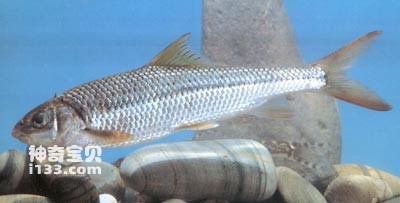Onychostoma macrolepis, formerly known as Onychostoma macrolepis, belongs to the order Cypriniformes, the family Cyprinidae, the subfamily Onychostoma macrolepis, and the genus Onychostoma macrolepis. Commonly known as: money fish, white-scaled fish, and red-scaled fish. English name: Largescale shoveljaw fish.
The body is long, slightly flattened on the sides, slightly raised on the back, and round in the abdomen. The head is short, the snout is blunt, the mouth is inferior, with transverse cleft, and the corners of the mouth extend to the lateral edge of the ventral surface of the head. The edge of the lower jaw has sharp horn; there are 2 pairs of barbels, the upper jaw barbels are very small, and the barbels at the corners of the mouth are also very short. The dorsal fin has no spines and the outer edge is slightly concave. The scales on the chest are smaller and buried under the skin. The back of the body is dark brown and the belly is grayish white. There are crescent-shaped black spots at the base of each scale on the side of the body, the dorsal fin and caudal fin are gray-black, the other fins are gray-yellow with golden outer edges, and the dorsal fin and anal fin have an orange-red stripe.

It inhabits rivers with gravel bottoms, clear water, low temperature, high flow speed, and an altitude of 300-1500 meters. It often develops with the help of springs in lava cracks and caves in the river, and enters springs after autumn to overwinter. The springs emerge in mid-April. The springs are mostly concentrated in the middle of the night, with the heads facing inward and the tails facing outwards. They emerge in clusters. They usually finish emerging within 8-10 days. Males are generally sexually mature over 3 years old, and females are 4-5 years old. The number of eggs they can carry is 06-12,000. The reproductive season is from late May to late July. It feeds on aquatic invertebrates and algae growing on the surface of gravel. When feeding, it shovels with its mandibles, then turns its body over and breaks the food into its mouth. White spots can be seen on the stones after feeding.
Distributed in the middle and upper reaches of the Jialing River and Han River systems, the upper reaches of the Huaihe River, the Weihe River system, the Yihe River, the Luohe River, the Hutuo River in the upper reaches of the Haihe River, and Mount Tai in Shandong.
The flesh of the scaly shovel-jaw fish is tender and delicious, and has the effect of nourishing and improving eyesight. It is a top-quality fish from mountain streams. The population is relatively large in production areas, especially in the mountainous areas of southern Shaanxi where it is the dominant population. When the fish emerge from the springs in mid-April, the number is very large. Some larger fish springs can weigh more than 10,000 kilograms, usually several thousand kilograms, and small fry can weigh more than a hundred kilograms. They are a mountain specialty that the local people like to eat. . If its natural resources can be protected in the future and technical problems such as artificial breeding can be solved at the same time, it will be a promising farmed fish in mountainous fisheries.
animal tags:
We created this article in conjunction with AI technology, then made sure it was fact-checked and edited by a Animals Top editor.